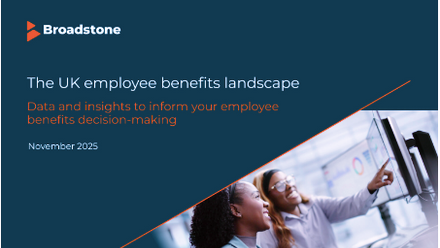How to use income protection cover to support early intervention
Increasing numbers of employers have been adding income protection cover to their benefits toolkit over the last year as they look to support employees’ physical, mental and financial wellbeing through the current financial turbulence.
Income protection insurance is an important buffer against financial risk at a time when employees are feeling the bite from the cost-of-living crisis, rising energy prices and a quarter of UK adults have less than £100 in savings, leaving them vulnerable in the event of a long-term sickness or injury.
However, as well as paying out for the long term (the average annual claim paid in 2020 was £28,138), income protection can offer more immediate support to employees and prevent them needing to submit a claim in the first place – leading to better employee outcomes, reduced absenteeism and lower costs to the employer.
It has traditionally been seen as a reactive insurance product to support employees through long–term absence, but things have developed considerably over the last 15 year.
Insurers are offering added-value services to support employees before they reach the point of needing to claim, to help them at the early stages of illness. And this difference in approach from insurers is working.
Figures from Zurich show that one in three people supported by a case manager returned to work before the insurance benefit became payable. Some of the free services insurers may offer virtual GPs, second opinions, early intervention consultations, physiotherapy and counselling.
Few employers are aware that income protection cover can be used in this way – but its benefits are considerable.
The importance of early intervention
Early intervention has a strong impact on employee outcomes:
• According to Zurich, more than 90% of cases referred within four weeks of the first absence return to work, whereas fewer than 5% of cases referred at 26 weeks or later after the first absence are able to return to work.
• With the help of the early intervention team at Canada Life, nine out of 10 absentees return to work rather than making a claim.
• 80% of employees that Aviva provided rehabilitation support for returned to or remained at work.
As these statistics highlight, getting help at an early stage of illness significantly improves employee outcomes. By contacting your insurer within the first few weeks of absence, the insurer can start to engage employees and provide the support they need.
On the other hand, later notifications of claims results in a higher cost of intervention and increases the cost for the employer (for example, due to the impact on the team, recruitment, training and insurance premiums).
For physical illnesses, the importance of routine check-ups and screenings is already widely encouraged. Unfortunately, this principle isn’t always applied to mental health – where support is often focused on later stages.
Yet mental health is one of the key drivers of income protection claims – in 2020, the average new claim paid was £28,138 pa and the main causes for claims were cancer (28%) and mental illness (22%).
Some of the services insurers offer such as counselling can help prevent conditions from worsening, therefore it’s crucial to follow an early intervention policy for mental as well as physical illness.
How to adapt your strategy
1. Early notification
With the right processes, HR teams can ensure the relevant people in the company are aware how they can help employees use income protection for early intervention.
According to Zurich, being notified within four to six weeks means insurers are more likely to be able to support the member to return to work within the six-month deferred period, for more mild to moderate conditions.
Most insurers will also run awareness webinars and provide training for line managers to help them start intervention earlier.
2. Don’t set and forget
When was the last time your organisation reviewed your income protection plan to see if early intervention strategies are available? Now is the time to find out what’s in place for employees and review your strategy to ensure you’re using the programme for early intervention and not just claims.
3. Review cases monthly
If you’re working with a benefits consultant, they should be helping you to review active cases monthly, so you can use income protection cover to support current employee absence.
Although income protection cover is only often brokered every two years, using your policy in a more preventative way can lead to better employee outcomes, keep premiums down (due to fewer claims) and address absence as well as the associated costs of things like recruitment, training and the impact on the wider workforce.
Income protection cover as part of wellbeing strategy
Employees today expect more from their employers than ever. Benefex’s Great Expectations report earlier this year, which surveyed more than 4,000 employees worldwide, found 77% said that their expectations of their employer had increased since the pandemic. And 90% said it was important that employers supported their wellbeing.
As employers look to support employees’ physical, mental and financial wellbeing in financially uncertain times, income protection is a must-have part of the benefits toolkit. By shifting your strategy and using income protection as an early intervention tool you can ensure better outcomes as well as realise tangible savings for your organisation.
Supplied by REBA Associate Member, Benifex
The home of award-winning employee benefits, reward, recognition, & communications.








